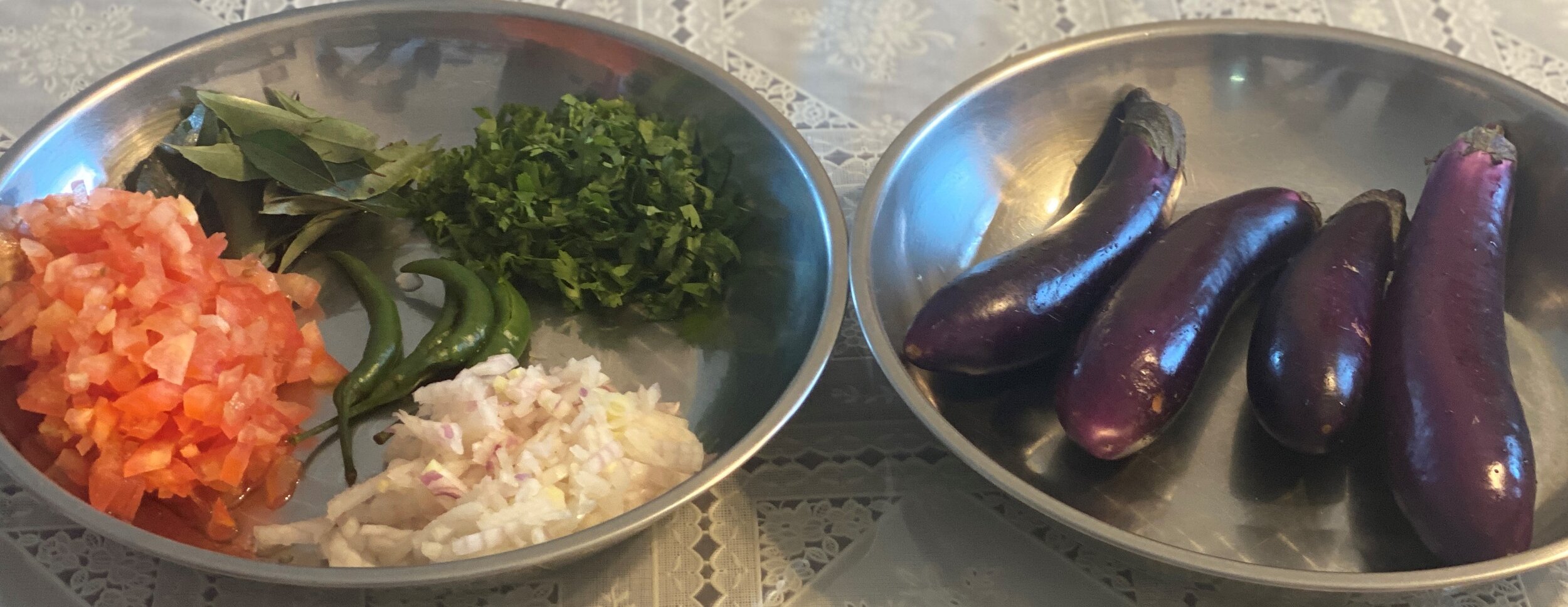Kathirikkā Kathirikkā Gundu Kathirikkāi Kosamalli
In talking to another apprentice about Ayah’s Kitchen recipes I thought were easy and she should attempt, the first comment was “I don’t have a blender, so don’t tell me to make anything that needs one!” While my repeated advice to her and other young cooks who would like to experiment with Indian food is to invest in both a blender and a pressure cooker, I do understand that it may not always be feasible. And so, I will attempt to include some easy recipes that don’t require “fancy” equipment and can be made with the pots and pans in your kitchen.
Kathirikkai Kosamalli is one of those recipes – traditional to most Chettiar homes, yet simple to make. Kosamalli is a mildly spiced, smoky, tangy eggplant curry (for want of a better word), a favourite both at home and at celebratory feasts, usually served with idlis or idiyappams (stringhoppers), but can be had with a bowl of steamed rice too. And the best news for the time poor young wannabe cooks out there – it can be stored for at least a week in the refrigerator.
Discussions about time poor wannabe cooks sans fancy kitchen equipment, bring back memories of a poor graduate student living in the blistering cold of a fairly remote part of America in the late ‘90s. Ayah insisted that I pack a pressure cooker along with the ubiquitous Indian spices that I hadn’t the faintest idea what to do with, but the blender was something neither she nor I thought would survive the tiny kitchen that I shared with a couple of Phd students, one Chinese and one American. While I can’t remember if there was an Indian restaurant in the neighbourhood, there were a few Indian students whose kitchens were better equipped than mine. My fondest memories are of dinners at a neighbour’s, one who became a good friend because he had two prized possessions – a television and a blender! Watching masala movies with an eclectic bunch of South Indian food starved desis, feasting on homemade dosais made by one of those few masterchefs who owned and knew how to operate a blender was a novelty indeed! The then young electrical engineering doctorate student, now a CEO, to this day remains a passionate cook, which suits his wife just fine!
While I did experiment with some Indian cooking in those days, I must say that as a young cook in training, the rather underrated non-descript looking, mildly spiced kathirikkai kosamalli, simple as it was, was not on my list of must learn recipes. I only learnt to savour the subtle yet delicious flavours when I grew up a little bit more, landed up in Australia as a young bride, and was reintroduced to it by my mother-in-law, who also makes a mean version of it. Today though, when I make idiyappam (or buy it from the store), the only accompaniment that comes to mind is kosamalli. Of course, my extremely sweet toothed children prefer to dunk their strings in sweetened coconut milk, but wait until you are older, I say.
Image courtesy: https://www.homestratosphere.com/
The dish requires not much more than the hero, the egpplant and so picking the vegetable (which technically is a fruit or rather a berry) and preparing it is the most important part. The gundu kathirikkai, from the popular Tamil song, the big fat Italian eggplant, is the most commonly available variety overseas, and lends itself well to the dish. However, I prefer the long, slender Asian version, the neela kathirikkai, because it is less fibrous and a bit more flavourful. The grafitti eggplant, light purple and white striped, is an acceptable option as well. Once you’ve picked your eggplant, it is time to prepare it, the next most important step. I like roasting the eggplant either over an open flame or grilling it in the oven because the smokiness the char lends to the dish takes it to the next level; however, boiling the eggplant, a less time intensive method, is perfectly acceptable, and one that my mother-in-law swears by. Either ways, you have a cracker of a dish on hand, one that should take you less than 30 minutes from chopping board to table – try it and let us know how it turns out.
Notes:
1. The kathirikkai (baingan / eggplant / aubergine) is the hero of the dish, so make sure you pick the right one. The big dark purple Italian eggplant is readily available option, but I personally prefer the long slender Asian eggplant because it is less fibrous and more flavoursome. The streaky graffiti eggplant is a good susbsitute too. Go with whatever you find at your local grocer.
2. There are a few methods to prepare the eggplant - roasting over an open flame, grilling in the oven or on a barbecue and boiling. While my favourite method is roasting over a open flame because the char lends a deliciously smoky flavour to the dish, this is time consuming. If you are pressed for time, stick to the boiling method.
3. Some people add potato to the recipe; however, I personally do not like it and only add it if the kosamalli is too spicy.
4. I veer from the original recipe in adding a pinch of jaggery in the end to balance the flavours; however, this is entirely optional.
5. This recipe serves 4, but can be halved if you'd like to make a smaller portion.
6. Any leftovers can be stored in the refrigerator for upto a week (if you are not using potatoes) or frozen for upto a month.
Ingredients:
~300 gm eggplant (kathirikkai / baingan / aubergine; should yield 1 cup when roasted / boiled)
1 teaspoon tamarind paste or a small gooseberry sized ball of tamarind
1 medium onion
1 medium tomato
4 green / red chillies, slit (reduce if you want less spicy)
½ teaspoon red chilli powder (skip if you don’t want it spicy)
~ 3 cups water
Salt ~1.5 teaspoon
Some coriander leaves minced
For tempering:
1 tablespoon cooking oil
1 teaspoon mustard seeds
1 teaspoon urad dal (black gram dal / ulundam paruppu)
2 dry red chillies
A pinch of asafoetida (hing / perungayam)
Few curry leaves
Optional:
½ teaspoon powdered jaggery
1 medium potato, boiled and roughly mashed
Method:
1. Preparing the eggplant:
~300 gm eggplant (kathirikkai / aubergine; should yield 1 cup when roasted / boiled)
Option 1 - Roasting on an open flame
Apply oil all over the skin of the whole eggplant and stick a skewer through it.
Roast on an open flame, rotating the eggplant regularly until the skin is mostly charred. This gives the smoky flavor.
Transfer the roasted eggplants to a bowl of cold water and let it cool.
Once cooled, remove the skin and set aside.
Option 2 - Grilling in an oven
Apply oil all over the skin of the whole eggplant(s) and and arrange on an oven-safe tray.
Set your oven to grill setting at about 180 C (~350 F) and grill the eggplant, turning it regularly until the skin is mostly charred. This gives the smoky flavor.
Transfer the roasted eggplants to a bowl of cold water and let it cool.
Once cooled, remove the skin and set aside.
Option 3 - Boiling
Put the whole eggplant(s) in a saucepan and cover it with water. The water should just cover the eggplant(s).
Bring to a boil and cook until the skin starts peeling.
At this stage, turn of the flame and drain the water out. Let the eggplant cool.
Once cooled, remove the skin and set aside.
2. Chop the eggplant roughly and transfer to a saucepan. Remember to cut off the hard cap of the eggplant.
3. If using fresh tamarind, soak in 1/2 cup of warm water and extract the juice. Remove the pulp and only use the water. If using paste, mix the paste with 1/2 cup of warm water until dissolved.
1 teaspoon tamarind paste or a small gooseberry sized ball of tamarind
1/2 cup water
4. Mince the onion and tomatoes and slit the green / red chillies and add to the eggplant. Set about a tablespoon of the onion aside for tempering.
1 medium onion
1 medium tomato
4 green / red chillies, slit (reduce if you want less spicy)
5. Mix all of the above, mash a bit with the hand, add salt, tamarind water and the remaining 2 1/2 cups water. If you want it a bit more spicy, add the chilli powder, otherwise leave out.
½ teaspoon red chilli powder (skip if you don’t want it spicy)
~ 2 1/2 cups water
Salt ~1.5 teaspoon
6. Partially cover the saucepan and simmer the mixture until the onions and tomatoes are cooked. This should take about 15 minutes. Add more water if you want it more watery. Adjust salt to taste.
Note: If the the kosamalli is too spicy, roughly mash 1/2 to 1 boiled potato (should still see some chunks) and add to kosamalli at this stage and simmer for a few minutes.
Optional: 1 medium potato, boiled and roughly mashed
7. At this stage, add the jaggery if you are using and continue to simmer until dissolved.
Optional:
½ teaspoon powdered jaggery
8. In a separate pan, while the kosamalli is cooking, heat the oil, add the mustard and urad dal. When mustard pops, add the chilli and asafoetida, curry leaves and the reserved onions and stir for a few seconds. Remove and pour over the kosamalli.
For tempering:
1 tablespoon cooking oil
1 teaspoon mustard seeds
1 teaspoon urad dal (black gram dal / ulundam paruppu)
2 dry red chillies
A pinch of asafoetida (hing / perungayam)
Few curry leaves
9. Mix in and garnish with minced coriander. Serve hot with idlis or idiyappams or even with a bowl of steamed rice.
Serves: 4 people
Apprentice Rating: Easy if you use the boiling method; Medium, if you roast the eggplant
Recent Posts:












